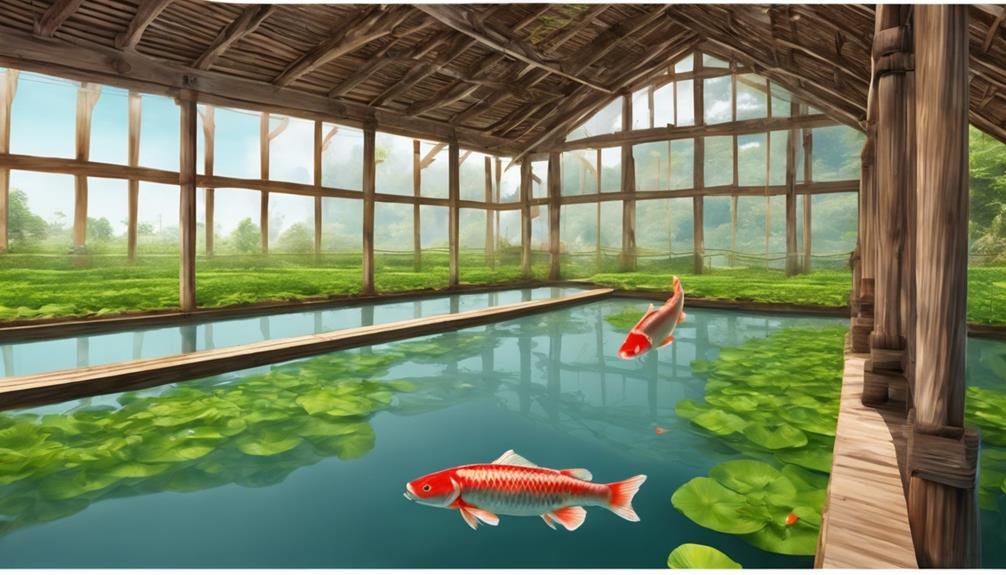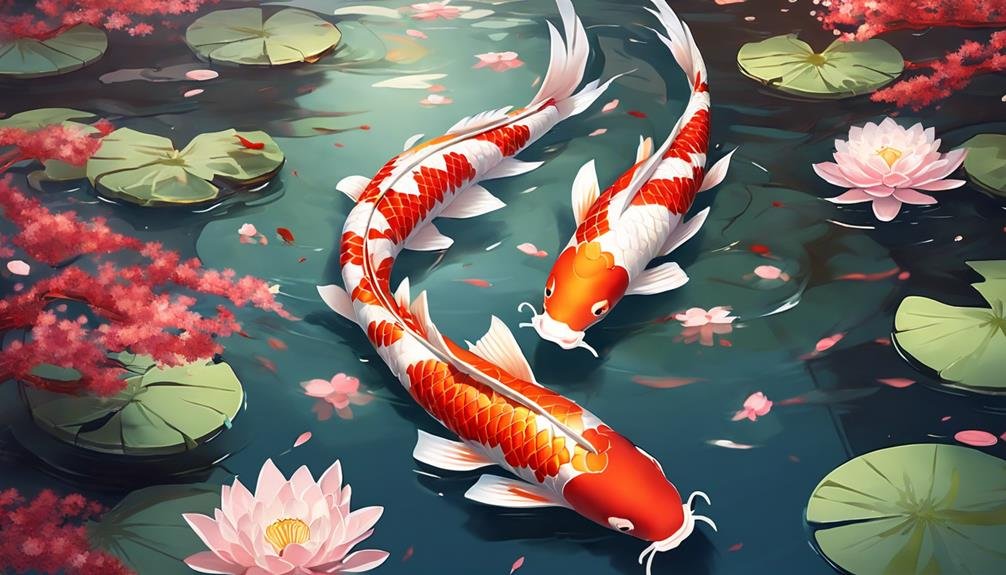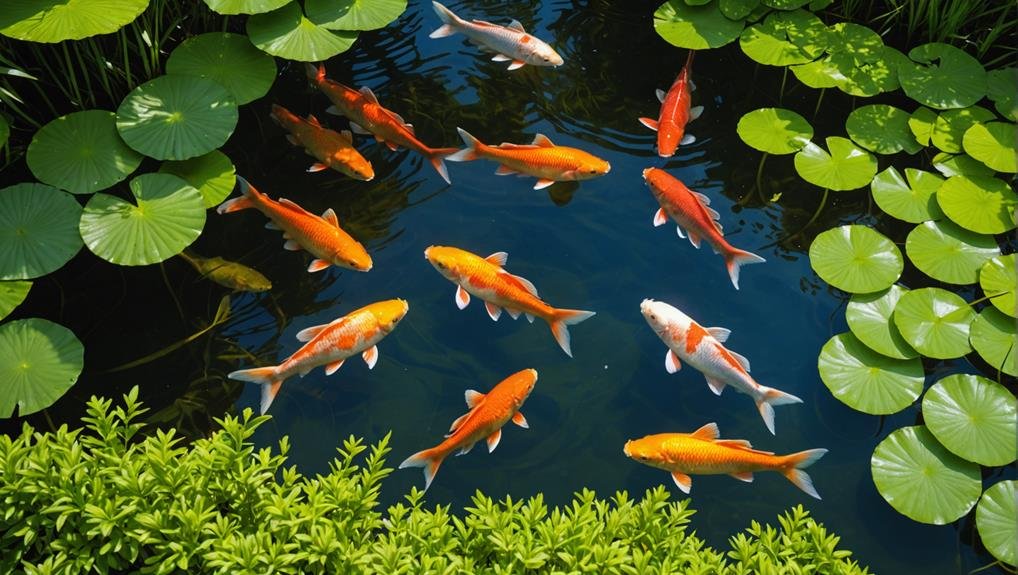When you think about carp fish, you might picture them as just another species in a pond, but there’s so much more to their story. Known for their impressive longevity and adaptability, carp have a significant presence in freshwater habitats and recreational fishing circles, particularly in Europe and the US. Their role in aquaculture is equally fascinating, where selective breeding has turned them into robust commercial assets. And let’s not forget their cultural and culinary significance, especially in traditional European dishes. But what makes carp fish stand out, and why do they hold such symbolic value in Asian cultures?
Key Takeaways
- Carp are freshwater fish from the family Cyprinidae.
- Carpets are popular for recreational fishing due to their fighting strength.
- Carp are selectively bred for faster growth and disease resistance in aquaculture.
- Carp are a staple in traditional European dishes and hold rich symbolism in Asian cultures.
- Optimal carp fishing involves understanding their seasonal behavior and preferred habitats.
Carp Biology and Habitat

Although carp have been domesticated for thousands of years, they retain fascinating biological traits and habitat preferences. Belonging to the family Cyprinidae, carp are mainly freshwater fish and come in various species, including the well-known common carp. These fish are bottom feeders, meaning they often forage along the riverbed or lake floor, using their inferior pharyngeal teeth to crush food.
As members of the order Cypriniformes, carp possess Weberian ossicles, specialized structures that enhance their sound perception, making them highly attuned to their environment. Genetic diversity among carp species is notable, with some, like the Tribolodon genus, even capable of tolerating saltwater. This adaptability showcases the wide environmental range carp can inhabit.
The common carp, listed as vulnerable, can live up to 40.1 years, reflecting its resilience and adaptability. While it’s mainly a freshwater dweller, its ability to thrive in varied conditions has led to widespread domestication across Europe and Asia.
Despite human intervention, carp maintain their natural behaviors and preferences, continuing to intrigue scientists and enthusiasts alike with their complex biology and habitat versatility.
Recreational Fishing for Carp
Carp’s intriguing biological traits and habitat preferences make them captivating subjects of study and popular targets for recreational fishing. In Europe, carp are highly valued coarse fish, with a thriving carp angling market, especially in the UK. Specialized publications and communities are dedicated to this sport.
Across the pond, in the US, common carp are often classified as rough fish. Despite this, they’re gaining recognition for their sporting qualities, particularly in the Midwest, where their fighting strength makes them a sought-after species for recreational fishing.
To successfully target carp, observing their behavior and feeding patterns would be best. Carps typically feed on crustaceans, insect nymphs, and aquatic worms. Understanding these patterns can greatly increase your chances of a successful catch.
Effective carp fishing techniques require a strategic approach. Heavier-weighted flies can help keep your bait in the fish’s feeding path. Presenting the fly in a manner that mimics natural movement and avoiding actions that might spook the carp are essential. By fine-tuning your tactics and respecting the carp’s natural tendencies, you can enjoy a rewarding carp angling experience.
Carp Aquaculture and Breeding

Carp aquaculture and breeding have been integral to meeting the global demand for this versatile fish. With a history spanning thousands of years, particularly in Europe and Asia, carp species have been domesticated to provide a reliable food source. China’s long-standing tradition in aquaculture has driven significant advancements, especially in the induced breeding of major carp species. These breakthroughs have played a critical role in the rapid expansion of freshwater aquaculture.
In modern carp aquaculture, selective breeding programs are essential. These programs focus on genetic selection to enhance desirable traits such as growth rate, shape, and disease resistance. Improving these characteristics ensures that carp are not only healthier but also more suited for commercial production.
Selective breeding has led to carp that grow faster and are more resilient to diseases, making them ideal for large-scale aquaculture operations.
These advancements greatly benefit commercial production, allowing for a more consistent and high-quality supply of carp. The emphasis on growth rate and disease resistance means you can produce carp more efficiently, meeting the ever-increasing demand for this nutritious fish worldwide.
Carp in Culinary and Cultural Context
You might be surprised to learn that the common carp plays a key role in traditional Christmas Eve dinners in some European countries, highlighting its cultural importance.
In Asia, carp is celebrated for its rich symbolism. It is often depicted in Chinese literature and legends like the Dragon Gate, where it represents success and perseverance.
Carp dishes also vary globally, although preferences differ. Bighead carp are popular worldwide but less so in North America.
Traditional European Dishes
During the festive season, especially Christmas Eve, carp takes center stage in many European households. This fish is a staple in several traditional European dishes, making it a highlight of festive occasions. In Czech cuisine, a classic Christmas meal often includes fried carp served with potato salad, a tradition passed down through generations. Poland and Germany also feature carp prominently during their Christmas celebrations, each with unique preparations.
In Germany, carp is fried or baked, reflecting the country’s rich culinary diversity. The common carp, a staple in European culinary traditions for centuries, brings families together, creating memories around the dinner table.
Here’s a glimpse of how carp is enjoyed in different European countries during festive occasions:
| Country | Dish | Occasion |
|---|---|---|
| Czechia | Fried carp with potato salad | Christmas Eve |
| Poland | Carp in aspic | Christmas Eve |
| Germany | Fried carp | Christmas Eve |
| Austria | Baked carp | Christmas Day |
| Slovakia | Breaded carp | Christmas Eve |
Consider embracing these European traditions when you gather around the table this holiday season. Carp not only brings flavor but also a sense of cultural heritage and connection to festive occasions.
Cultural Symbolism in Asia
Rooted deeply in Asia’s cultural fabric, the carp holds a prominent place in culinary traditions and symbolic representations. Carp are celebrated in Chinese culture and literature, symbolizing perseverance, success, and transformation into dragons.
The legend of the Dragon Gate tells of carp swimming upstream against strong currents. Those who make it past the gate are said to transform into powerful dragons, embodying themes of determination and achievement. This tale underscores the carp’s cultural symbolism of persistence and ultimate success.
In Japan, carp, particularly koi fish, are ingrained in cultural and artistic expressions. Koi represent luck, strength, and resilience, often depicted in traditional art and garden ponds. The Japanese admire the koi’s ability to swim upstream, reflecting human qualities of perseverance in the face of adversity.
Carp’s significance extends to their culinary use across Asia. Whether in Chinese steamed dishes or Japanese sushi, they highlight the fish’s versatility and importance in regional cuisines. When you enjoy a carp dish, you partake in a tradition-rich with meaning and history, celebrating the carp’s symbolic journey of transformation and resilience.
Koi Fish in Japanese Culture

Koi fish are more than just ornamental pond dwellers in Japan; they’re vibrant symbols of luck, strength, and tenacity deeply embedded in Japanese culture. These modern Japanese Amur carp, selectively bred for their striking colors and patterns, are celebrated for their rich symbolism. In Japanese art, koi fish often appear in paintings and tattoos, embodying the qualities of luck, strength, and resilience. Their graceful presence in these mediums isn’t merely decorative; it reflects the values they represent.
In Japanese culture, koi fish are seen as symbols of love, gratitude, and peace. They’re frequently given as gifts, symbolizing respect and appreciation. This tradition highlights how deeply koi fish are woven into Japanese social and cultural practices. Samurai warriors admired koi fish for their bravery and resilience, seeing in them the strength and determination they aspired to embody.
Koi fish serve as powerful metaphors for positive qualities in various contexts. Their enduring presence in Japanese culture underscores their role as reminders of perseverance and grit. Embracing koi fish in art and tradition enriches the appreciation of these remarkable creatures and their significance.
Carp Fishing Techniques and Locations
To successfully catch carp, you must master casting strategies that avoid spooking them, like approaching from behind and using heavier flies.
Prime habitats include sandy riverbanks, lake coves, and areas near vegetation where carp gather.
Keep an eye on their seasonal behavior, especially since they feed near the banks in the early morning and late afternoon.
Effective Casting Strategies
Regarding effective casting strategies for carp fishing, approaching these wary fish from behind and presenting the fly directly in their feeding path is vital. Carp are incredibly cautious, so sneaking up from behind helps you stay out of their line of sight. This is essential for carp fishing success.
Focus on areas near the shore or on sand bars in rivers, where carp often feed, to increase your chances of a successful catch.
Using lead wraps or dumbbell eyes on your fly can help it sink quickly to where the carp are feeding. This makes your casting strategies more efficient, ensuring your fly lands before the fish. Walking upstream and avoiding loud footsteps will keep you from spooking the carp.
Another technique to contemplate is dapping. By keeping your fly within dapping range, you can present it gently on the water’s surface without causing a splash. This is particularly effective for targeting carp feeding on insects near vegetation.
Prime Carp Habitats
Prime carp habitats are essential for successful carp fishing, and knowing where to find these fish can make all the entire difference. Whether targeting common carp in rivers or exploring lakes, understanding their preferred environments is key.
In rivers, common carp often congregate near the shore or on sandbars. Walking upstream quietly and avoiding loud footsteps helps prevent spooking them, boosting your chances of success. Look for areas where the water slows down, such as behind rocks or near bends. These spots are goldmines for carp fishing.
Lakes offer unique opportunities as well. Flats and coves are ideal spots, especially those with shallow waters. These areas attract carp searching for food, making them prime locations for your angling efforts. To maximize your success, focus on:
- Flats: Shallow, level areas in lakes where carp feed.
- Coves: Sheltered spots with calmer waters, perfect for fly fishing.
- Sandbars: Raised areas in rivers where carp often linger.
Carp tend to move towards the banks during the early morning and late afternoon. Timing your fishing trips during these periods can notably improve your chances of a successful catch. Happy fishing!
Seasonal Behavior Patterns
Understanding prime carp habitats establishes the foundation for successful angling, but recognizing their seasonal behavior patterns can enhance your fishing game even more. As the seasons shift, so do common carp’s feeding patterns and movements.
When temperatures rise in spring, carp become more active and can often be found feeding in shallow waters, around 3-5 feet deep. These areas warm up quicker, creating ideal fishing spots.
In summer, carp seek out cooler, deeper waters or shaded areas like coves and under overhanging trees to escape the heat. During this period, observing environmental factors such as water clarity and temperature is vital. In clearer waters, carp might be more cautious, requiring stealthier approaches.
Come autumn, carp feeding patterns shift again as they prepare for winter. They tend to forage heavily in shallower waters, often around sand bars, to build energy reserves. This seasonal shift is a prime time for anglers to target them.
Winter poses a challenge as carp become sluggish and move to deeper waters. However, understanding these seasonal behavior patterns and adapting your techniques accordingly can greatly improve your chances of success. Knowing where and when to fish ensures you’re always one step ahead.
Conclusion
You’ve now got a solid understanding of the fascinating world of carp fish. Whether you’re intrigued by their biology, enjoy the thrill of catching them, or appreciate their culinary and cultural significance, carp fish truly offer something for everyone. Their presence in aquaculture and recreational fishing showcases their enduring importance. So, next time you encounter a carp, remember the rich tapestry of history, culture, and science that swims alongside it.
FAQs
What is a carp fish?
Carp are a type of freshwater fish belonging to the Cyprinidae family. They are known for their size, adaptability, and strength, making them a popular species for anglers. Common species include the common carp, mirror carp, and grass carp. Carp are often found in lakes, rivers, and ponds with slow-moving or still water.
Key Facts:
- Freshwater fish from the Cyprinidae family.
- They are known for their size and adaptability.
- It is commonly found in lakes, rivers, and ponds.
What are the most common species of carp fish?
Some of the most common species of carp include:
- Common Carp: The most widespread species, known for their golden-brown color and large size.
- Mirror Carp: A variation of the common carp with large, irregular scales.
- Grass Carp: Herbivorous carp that feed mainly on aquatic plants.
- Koi Carp: A domesticated variety, often kept in ponds for ornamental purposes.
Popular Species:
- Common carp.
- Mirror carp.
- Grass carp.
- Koi carp (ornamental).
Where can you find carp fish?
Carp are highly adaptable and thrive in freshwater lakes, rivers, ponds, and canals. They prefer slow-moving or still water with plenty of vegetation, where they can find food and shelter. Carp can tolerate a range of water temperatures and conditions, making them one of the world’s most widely distributed freshwater fish.
Habitat:
- Lakes, rivers, ponds, and canals.
- Prefer slow-moving or still waters.
- Thrive in vegetated areas with plenty of food sources.
What are the best techniques for catching carp?
To successfully catch carp, use the following techniques:
- Bait Selection: Carp are attracted to various baits, including boilies, corn, dough balls, and bread. Choose bait that mimics their natural food sources.
- Chumming: Carp responds well to pre-baiting or chumming the water with loose bait to draw them to your fishing spot.
- Patience: Carp can be wary, so it’s essential to be patient and allow the fish to take the bait without spooking them.
- Float or Bottom Fishing: Depending on water conditions and their feeding habits, carp can be caught using both float and bottom fishing techniques.
Fishing Tips:
- Use baits like boilies, corn, or bread.
- Pre-bait your fishing area to attract carp.
- Practice patience and avoid spooking the fish.
- Try float or bottom fishing based on conditions.
How big can carp fish grow?
Carp fish are known for their size and can grow quite large. Common carp can weigh up to 40-80 pounds (18-36 kg) or more in some cases, while mirror carp and grass carp can reach similar sizes. The largest carp are often found in well-stocked lakes with plenty of food.
Size:
- Common carp: 40-80 pounds or more.
- Mirror and grass carp: Similar size potential.

